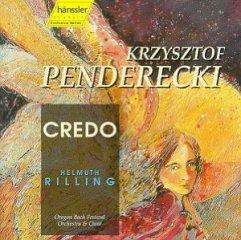Krzysztof Penderecki – Credo (2000)
Krzysztof Penderecki – Credo (2000)

1. Credo: I. Credo In Unum Deum 2. Credo: II. Qui Propter Nos Homines - III. Et Incarnatus Est 3. Credo: IV. Crucifixus 4. Credo: V. Et Resurrexit Tertia Die 5. Credo: VI. Et In Spiritum Sanctum - V. Et Vitam Venturi Saeculi Milagro Vargas (Mezzo Soprano) Thomas Quasthoff (Bass) Thomas Randle (Tenor) Juliane Banse (Soprano) Marietta Simpson (Mezzo Soprano) Oregon Bach Festival Orchestra And Choir Helmuth Rilling – conductor
In a world of recycled classics and countless renditions of chant, it's difficult to find something brand new to get excited about. But Penderecki's 1998 Credo is such a work, a masterpiece that should draw serious attention from all choral-music enthusiasts. This isn't only a choral piece, but a magnificently well-integrated work for soloists, choirs, and orchestra reminiscent of both the lean-textured clarity of Stravinsky and the most powerful orchestral utterances of Beethoven and Brahms. However, the Credo is not a montage of borrowed styles; it's an original and accessible work that vividly illuminates the meaning of this revered text. Although some patented Penderecki devices appear (ensemble speech, unusual percussive effects), Credo is notable for its more conventional use of harmony and melody. For centuries composers have sought to avoid or truncate the lengthy Credo text. Here, one of the 20th century's masters shows how to bring the words to life while successfully sustaining the musical momentum. The performance, by those for whom the work was commissioned, is an exemplary mix of beautiful choral sound and virtuoso orchestral playing. ---David Vernier, amazon.com
Commissioned by the Internationale Bachakademie in Stuttgart and the Oregon Bach Festival, the text for Penderecki's Credo is based on the standard Latin version of the Nicene Creed, and is scored for five soloists (SSATB), boys' choir, mixed choir, and orchestra. It was completed and premiered in 1998.
Penderecki at first sketched ideas for the various parts of the standard Mass but the Credo section, an integral part of the Mass placed between the Gospel and the Offertory since 798, had "gone beyond the dimensions I had planned." Like Bach and Beethoven, Penderecki decided to set the entire Credo secton: "The Credo is the most important text ... Every idea in the Mass is included here."
Penderecki wrote his first large scale religious work in 1966 with the Passion According to St. Luke. That year was significant in Poland as the thousandth anniversary of Poland's acceptance of Christianity in its Roman form by King Miesko, which pointed their culture toward the West in opposition to the Eastern Orthodox influences. Penderecki continues his commitment to religious creations: "Since I am a Christian and compose as a Christian, I must write another major religious work ... Looking at other composers of our time, there is only one--Olivier Messiaen--who has written as much music on sacred texts. This is my task!"
Penderecki divided his Credo into five sections, like Beethoven, and also included eight interpolations. Throughout this work Penderecki calls upon compositional techniques and styles of roughly the last 250 years in quest of a universalist style that may appeal to wide audiences. Similar endeavors by Górecki, Andriessen, Pärt and others have been referred to as the New Religiosity, or the New Romanticism. For example, in the first section "Credo in Unum Deum" (I Believe in one God), the choir enters in unison with a Gregorian chant-style line that immediately becomes powerfully harmonized in a fully tonal Romantic manner. This continues until after the words "et in unum Dominum Jesum Christum, Filium Dei unigenitum ... " (I believe in one Lord Jesus Christ, only-begotten Son of God). A baritone solo then enters against chromatically modulating chords with the words "et ex patre natum ante omnia saecula" (born of the Father before time began). The choir gradually brings the tonality back to the minor key as in the beginning.
II. "Qui propter nos homines" (He for us people, and for our salvation, came down from heaven) is built from ascending and descending chromatic lines which perfectly describe the image.
III. "Et incarnatus est" (And was incarnate by the Holy Spirit) continues the chromatics, but suddenly breaks into a light-hearted, spirited and joyful "Ex Maria Virgine. Et homo factus est." (from the Virgin Mary and was made man).
IV. The "Crucifixus" is more somber in tone and employs more advanced harmonies than the previous sections. This section includes four interpolations: the "Crux fidelis" (Faithful cross, above all other), the "Pange lingua" (Sing, O tongue, the glorious battle), two Polish liturgical hymns, and the German chorale "Aus tiefer Not schrei ich zu dir (Out of the depths, I cry to thee).
V. "Et Resurrexit Tertia Die" is both rhythmically punctuated and mysterious.
VI. "Et in Spiritum Sanctum" beautifully combines the previous chromatic lines and tonality in a transcendent feeling of heavenly flight. There are also brief quasi-random speech passages, like Penderecki's 60s style, and rich twelve-tone tension.
VII. "Et Vitam Venturi Saeculi" (and the life of the world to come) approaches the final major "Amen" chord by gradually ascending dramatic pleas. --- "Blue" Gene Tyranny, Rovi
download: uploaded yandex 4shared mediafire solidfiles mega filecloudio nornar ziddu








